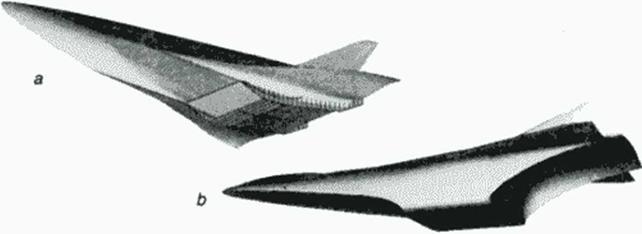Novel Configurations
The development of conventional high speed transport configurations like the generic HSCT configuration may still face crucial technology problems resulting in reduced chances to operate economically, as it is critically reviewed in various chapters in this book. New concepts, on the other hand, are emerging, but they must be studied in great detail using reliable theoretical, numerical and experimental analysis tools before any project can be laid out for development of a first aircraft.
All-body and all-wing configurations
From the viewpoint of using the presented geometry generator for support of such new concepts, it seems that promising new configurations can be generated if the two types of shapes, axially and spanwise defined components, are not any longer restricted to their traditional roles of representing fuselage and wing, respectively. There is rather an attractive alternative emerging by either type of component taking over both functions:
All-body aircraft as well as all-wing configurations arc limiting cases where either wing or fuselage is vanishing and the remaining component taking over both functions which are providing volume as well as lift. Wavenders as illustrated in the previous book chapter are fully integrated configurations; guided by the outlined knowledge base of inverse design it is now relatively easy to create arbitrary direct design cases with wavender characteristics (II5J, there is just no "on-design" condition flow field coming with the design geometry. Suitable choice of geometry parameters to simulate inverse design cases but allow ing a 4D optimization extension as outlined above most likely will lead to further improvements. Generic hypersonics asks for integrated configurations, favorably based on the wavender concept: Direct geometry generation using cither the wing tool (Figure 67a) or the body tool (Figure 67b) for the integrated wing body components can solve this task.
|
Figure 67 Aerospace plane configuration geometry models with wing-body-propulsion integration. |
All-wing or Flying Wing aircraft ha* several advantages reviewed in other chapters of this book; here its attractivity for both aerodynamics and structures in high speed flight just means that we may focus on case studies to model a variety of such Flying Wings as input for detailed analysis in a multidisciplinary approach.
Oblique Flying Wing
A shape with a relatively simple geometry at first sight is the Oblique Flying Wing (OFW). an ultimate example of adaptive geometry by adjusting the yaw angle of the whole configuration (exept the engines and control surfaces) to the vary ing flight Mach numbers (Figure 68). After several conclusions about the attractivity of this concept in this book, the two final chapters arc entirely devoted to the OFW. In the last chapter some studies are presented using our geometry software for OFW definition. Challenging tasks for systematic geometry parameter fine tuning emerge from the obtained results. Ongoing work will profit from a combination of this geometry generator w ith optimization tools as outlined in the following chapters.
|
Figure 68 Oblique Flying Wing model, with control surfaces and propulsion adjusted to the flight direction. |
9.5 Conclusions
Software for generic aerodynamic configurations has been developed to support the design requirements in the high speed regime. Based on simple, explicit algebra a set of flexible model functions is used for curve and surface design which is tailored to create realistic airplanes or their components with various surface gnd metrics. The explicit and non-iterative calculation of surface data sets make this tool extremely rapid and this way suitable for generating whole series of configurations in optimization cycles. The designer has control over parameter variations and builds up a knowledge base about the role of these parameters influencing flow quality and the aerodynamic performance coefficients. Gasdynamic relations and other model functions allow for the gradual development of our design experience if generic configurations arc used as boundary conditions for numerical analysis with mature CFD codes. Experimental investigations arc supported by CAD data which are delivered from the same geometry inputs as used for preprocessing numerical simulation. With efficient geometry tools available to the designer, the development of interactive design systems for not only aerodynamic but multidisciplinary optimization gets additional momentum.













